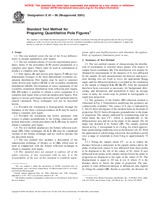We need your consent to use the individual data so that you can see information about your interests, among other things. Click "OK" to give your consent.
ASTM E81-96(2001)
Standard Test Method for Preparing Quantitative Pole Figures
STANDARD published on 1.1.2001
The information about the standard:
Designation standards: ASTM E81-96(2001)
Note: WITHDRAWN
Publication date standards: 1.1.2001
SKU: NS-48081
The number of pages: 7
Approximate weight : 21 g (0.05 lbs)
Country: American technical standard
Category: Technical standards ASTM
Annotation of standard text ASTM E81-96(2001) :
Keywords:
crystal, orientation, pole figure, X-ray diffraction, ICS Number Code 77.040.99 (Other methods of testing metals)
Additional information
| 1. Scope |
|
1.1 This test method covers the use of the X-ray diffractometer to prepare quantitative pole figures. 1.2 The test method consists of several experimental procedures. Some of the procedures (1-5) permit preparation of a complete pole figure. Others must be used in combination to produce a complete pole figure. 1.3 Pole figures (6) and inverse pole figures (7-10) are two-dimensional averages of the three-dimensional crystallite ori- entation distribution. Pole figures may be used to construct either inverse pole figures (11-13) or the crystallite orientation distribution (14-21). Development of series expansions of the crystallite orientation distribution from reflection pole figures (22, 23) makes it possible to obtain a series expansion of a complete pole figure from several incomplete pole figures. Pole figures or inverse pole figures derived by such methods shall be termed calculated. These techniques will not be described herein. 1.4 Provided the orientation is homogeneous through the thickness of the sheet, certain procedures (1-3) may be used to obtain a complete pole figure. 1.5 Provided the orientation has mirror symmetry with respect to planes perpendicular to the rolling, transverse, and normal directions, certain procedures (4, 5, 24) may be used to obtain a complete pole figure. 1.6 The test method emphasizes the Schulz reflection technique (25). Other techniques (3, 4, 5, 24) may be considered variants of the Schulz technique and are cited as options, but not described herein. 1.7 The test method also includes a description of the transmission technique of Decker, et al (26), which may be used in conjunction with the Schulz reflection technique to obtain a complete pole figure. 1.8 This standard does not purport to address all of the safety concerns, if any, associated with its use. It is the responsibility of the user of this standard to establish appropriate safety and health practices and determine the applicability of regulatory limitations prior to use. |



 Cookies
Cookies
